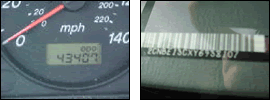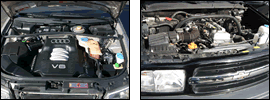 |


|
 |

Because most potential buyers will not have the opportunity to see your vehicle
in person, it is important that you provide multiple pictures in your listing.
People will buy a used vehicle without driving it, but not without seeing it.
An online transaction requires the seller to provide a virtual walk around.
This is best done with a minimum of 12 photos. We recommend a setting that
produces original pictures of 1024x768 pixels (a common size) or some values
close to that. Do not use stock photos.
Why are photos important?
-
Multiple photos have proven more effective when selling a vehicle.
-
Because photos speak for themselves, buyers are likely to have fewer questions
during the listing duration.
-
Photos provide buyers with added confidence in the seller and ultimately in
their bidding and purchase behavior.
Photos should be taken from several vantage points:
-
Exterior: all four sides
-
Interior
-
Engine
-
Odometer
-
Close-ups of any dings, dents, stains, or other damage

Photographing Your Vehicle

Generally, items listed with good photos receive more bids and sell for higher
prices than those with poor quality photos. Here are some photos tips for your
eBay auction.
Provide potential bidders with a full exterior view of your vehicle. At a
minimum, you should use ¾ views to capture the front, back, and both sides in
two photos; however, the more detail the better. To provide the most effective
listing it is important to include a direct front and rear photo along with
each side of vehicle to help identify the distinguishing make and model
characteristics of the vehicle. These views are useful, because they can also
show options like fog lights (front) or trailer hitch (rear).

As you walk around the outside of the vehicle, check to see whether there are
any other details that show the condition. In order to increase buyer
confidence, you should take photos of any notable issues including:
-
Dents, rust, interior damage, rips, tears, paint fade, and scratches
-
Cleanliness of wheels and tire tread
-
Grill and font end of car
-
Truck bed (if applicable)
Buyers should be aware of any known problems before they complete the purchase.
Many successful sellers use blue masking tape to highlight damage, because
damage is sometimes difficult to see in a digital picture.

Photograph all the details a buyer will want to see inside the vehicle. Make
sure to photograph the seats, dashboard, and any optional equipment (such as a
stereo), floor carpets, backseat, or other interior angles. Also include any
items that help identify optional equipment, such as trim level and condition.
Lighting is important for interior photos as shadows and poor lighting can make
them difficult to see online. Use of a flash for interior photos.

Take close-up photos of the odometer reading and the VIN. Take a picture of the
odometer reading with the keys in the ignition and the power turned on so the
mileage appears clearly in the photo.
Lighting is important for interior photos as shadows and poor lighting can make
them difficult to see online. Use of a flash for interior photos.

Buyers will want to know that the engine has been maintained and is in working
condition. This is especially true of older and collector vehicles. One photo
of the entire engine compartment with good lighting is usually adequate.


Tips on Taking Photos
 The car should fill the frame of the photograph.
The car should fill the frame of the photograph.

Background should be neutral, so that it is easy to see the vehicle.

Shadows and poor lighting can make photos difficult to see online. Shadows from
trees and buildings can obscure a clear view. Early morning or late afternoon
light is generally best for photos. You should have your back to the sun and
watch for shadows, including your own. Use a flash for interior and engine
shots.


|
 |